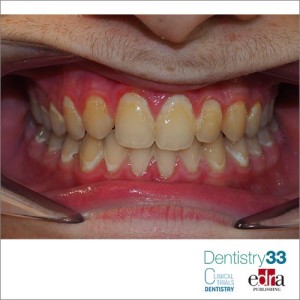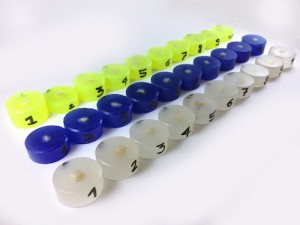
Post-orthodontic white-spot lesions: are resin infiltration and microabrasion effective treatment?
Co-authors: A. Comba, F. Florenzano
Lorenzo Breschi
The development of white spot lesions (WSLs) is one of the most common adverse effects of orthodontic treatment. During the orthodontic treatment the reduction of adequate oral hygiene due to the fixed appliances for a long period leads to the formation of WSLs. At least 50% of patients with fixed appliances develope one or more WSLs by the end of treatment. Therefore, during the orthodontic treatment enamel demineralization remains an issue, in particular because the progression of white spot lesions could affect the final esthetic outcome of the treatment. Nowadays, two different minimally invasive treatments are available on the market: resin infiltration and microabrasion. However, there are few clinical researches analyzing the pros and cons of the two treatment options.
The group of Xi Gu & al., from the University of Sichuan in Chengdu, China conducted a clinical study in order to evaluate differences in infiltration and microabrasion protocols outcomes. On one side, Resin infiltration, recently developed, aims to arrest carious lesions progression through the penetration of low-viscosity resin into the enamel depth. The resin creates a barrier inside the enamel substrate that avoid the penetration of acids and the arrests the progression of the demineralization. On the other side, Microabrasion could improve the appearance of teeth by eliminating the outer defective layer of the enamel. The protocol consists on the application of 6,6% hydrochloric acid associated with superficial enamel removal with 20- to 160- µm silicon carbide. At present, the long-term esthetic improvement of resin infiltration or microabrasion for in the treatment of WSLs is still unknown.
Materials and Methods
To evaluate the aesthetic results of the two treatment, the Chinese research group conducted a split mouth clinical study. The authors selected a total of 20 patients with 128 teeth presenting post-orthodontic WSLs. They employed a simple randomized, split-mouth, positive controlled design to allocate patients to the resin infiltration or microabrasion group. Inclusion criteria were patients from 12 to 19 years old who had finished fixed orthodontic treatment with debonding more than 3 months before the inclusion in the study and with the presence of WSLs on the anterior teeth induced by brackets. The exclusion criteria imposed by Xi Gu & al. were the presence of cavitated lesions and enamel defects, such as enamel hypoplasia, fluorosis, and tetracycline staining on anterior teeth. The authors calculated the lesion area ratio (R value) between the area of a WSL and the labial surface of the corresponding tooth based on standardized clinical photographs. The color change (DE) of each tooth was measured with a Crystaleye spectrophotometer (Olympus, Tokyo, Japan). Every measurement was taken before treatment (T0) and at 1 week (T1), 6 months (T6), and 12 months (T12).
Results
The authors selected a total of 16 patients with 108 teeth, 54 for each group. The analysis of the obtained data showed a significant decrease in the R value and DE between T1 and T0 (P < .0001). In the infiltration group, the R value and DE had no significant changes over time from T1 to T12. In the microabrasion group, the R value and DE decreased significantly from T1 to T6. The R value of resin infiltration was lower when compared with microabrasion at every recall point (P< .001). The DE had no significant differences between the two groups at any timepoint.
Conclusions
Considering the results obtained by Xi Gu & al., it can be concluded that resin infiltration and microabrasion are to effective protocols to improve the esthetic appearance of WSLs and showed good results after 12 months follow-up. However, Resin infiltration showed a better esthetic improvement effect when compared with microabrasion after 12 months.
For additional information: Esthetic improvements of postorthodontic white-spot lesions treated with resin infiltration and microabrasion: A split-mouth, randomized clinical trial.
 Tag
Tag
 Related articles
Related articles
Orthodontics 23 October 2023
How to prevent the appearance of white spots during orthodontic treatments
White spots (WS) frequently appear during orthodontic therapy with fixed appliances and usually appear in the gingival and vestibular parts of the teeth: the most affected by these lesions are the...
Orthodontics 03 May 2023
Impact of clear aligners on oral health, oral microbiome during orthodontic treatment
The present work highlighted further links between clear aligners and changes in oral health and the oral microbiome and provided plaque control methods for clear aligner trays.
Orthodontics 27 September 2021
Quality of etched enamel: bonding and development of white spot lesions
Enamel is a homogenous structure composed primarily of inorganic matter, organized into hydroxy- apatite crystal prism bundles. It has two distinct layers: an outer ‘‘prismless’’ enamel layer...
Restorative dentistry 16 March 2021
Evaluation of the remineralizing capacity of amorphous calcium phosphate on white spot lesions
Authors:Marco Calabrese Lorenzo Graiff Alberto Fioretti Matteo Fistarol
Dental caries is a disease that causes the destruction of the tooth due to the metabolic bacterial processes that take place within the oral biofilm. The term "caries" identifies the actual...
Oral Hygiene & Prevention 01 September 2020
Fluoride varnish and chlorhexidine gel on white spots in fixed orthodontic patients
Plaque accumulation which can lead to whitespot formation and gingival inflammation represent a significant challenge to excellence in clinical orthodontics. Dental ...
 Read more
Read more
Editorials 10 October 2025
With proud smiles and crisp white coats, ninety-three learners from the DDS Class of 2029 and the International Dentist Pathway Class of 2028 marked the start of their dental careers at the UCSF...
Periodontology 10 October 2025
Continuous professional development (CPD) in Periodontology refers to the overall framework of opportunities that facilitate a life-long learning practice, driven by the learner-practitioner and...
TheraBreath, the #1 alcohol-free mouthwash brand in the U.S.*, has introduced a new line of dentist-formulated, clinically tested toothpastes designed to support professional oral care...
News 10 October 2025
New officers and trustees were installed at the Minnesota Dental Association’s Leadership Conference on September 19 in Minneapolis.
News 10 October 2025
Smartee Denti-Technology today announced that Professor Gang Shen, its Chief Scientist and Executive President of TaiKang ByBo Dental, has once again been named to the World’s Top 2% Scientists...



.jpg)











